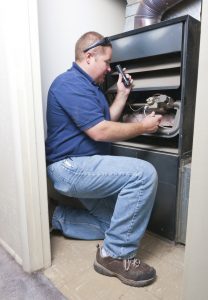Cool weather has arrived, and it’s going to get a lot colder before it gets warmer. Your household furnace should already be seeing plenty of use, and if you run into trouble with a breakdown or repair issue, it’s apt to catch you just when you need your system to reason the most. If you need furnace repair, now is the time to spot the issue and get it corrected.
Why now? Simply put, because you still have time to schedule repairs at leisure before the winter begins in earnest. You can set your own timetable and take care of the issue without having to alter your schedule or rearrange your life. It also means that, if repairs are necessary, they will usually cost less if you get them dealt with more promptly since the damage won’t have as much time to spread.
The bad news is that you should never attempt to actively diagnose a problem with your heating system, much less attempt repairs. Furnaces can develop gas leaks and other dangerous side effects, and without proper training and licensing, laymen are apt to cause more damage than they solve. Even diagnosis is problematic to someone without the proper credentials since a given symptom can have multiple possible sources.
Signs You May Need a Furnace Repair
The good news is that you don’t have to diagnose the problem to detect one. In general terms, anything that doesn’t correspond to the regular functioning of your furnace should merit investigation. More specifically, look for the following common symptoms of trouble when you turn your furnace on. This isn’t an exhaustive list by far, but it does cover some of the most overt signs that you need a furnace repair session.
- Strange Noises. A huge number of problems entails sounds or noises that you don’t normally associate with the function of your furnace: anything from hums and whistles to rattles and clangs. In most cases, the noises will start and stop in time with the starting and stopping of your air conditioner.
- Low Heating Levels. If the air emerging from your vents when you turn the heater on its cool, you know there’s a problem. The same principle holds true for air that is warm, but not as warm as you were expecting. It forces the furnace to work harder than it should: elevating monthly costs and raising the strain on the remainder of the system.
- Low Air Flow. Low air flow is usually created by a blockage, a leak in the ducts or some problem with the fan assembly. It has the same issue as low heating levels: forcing your system to work harder than it should to do its job.
- Refusal to Turn On. This is an obvious sign of trouble — the heater won’t turn on at all — but it usually stems from a safety issue, such as leaking gas or a malfunctioning ignition.
If you spot any signs of trouble with your furnace, turn the system off and call in a repair service immediately. Here in Newberg, OR, furnace repairs can be conducted by the friendly professionals at Western Heating & Cooling!

